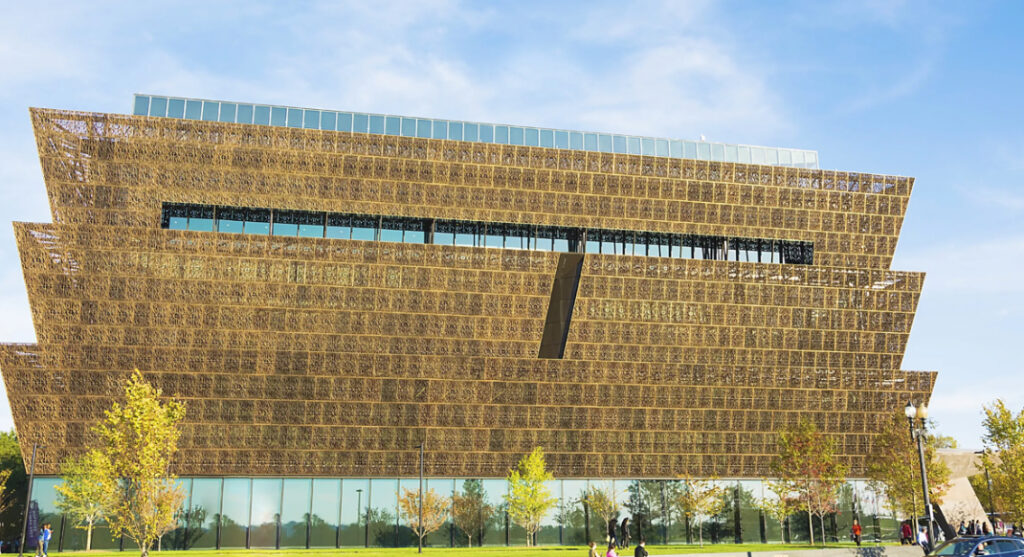- Theme: The museum focuses on African American life, history, and culture, emphasizing the importance of African American contributions to the national narrative and the interwoven nature of American stories with global influences. It aims to serve as a place of learning and collaboration, reflecting values like resiliency, optimism, and spirituality.
- Opening Hours:
- Monday: 12:00 p.m. to 5:30 p.m;
- Tuesday to Sunday: 10:00 a.m. to 5:30 p.m;
- Opens at 10:00 a.m. on Mondays observed as Federal Holidays. Closed on December 25.
- Official Site: https://nmaahc.si.edu;
- Phone Numbers: Not directly provided in the sources, but the museum can be contacted through the information available on their official website;
- Email: For timed-entry pass issues or inquiries, visitors can email [email protected];
- Ticket Price: Admission is free, but timed-entry passes are required for entry. These can be reserved in advance or obtained as same-day passes online.
The National Museum of African American History and Culture (NMAAHC), a beacon of heritage and an emblem of pride, stands not just as a monument but as a vibrant, living testament to the profound depths of African American life, history, culture, and contributions. As part of the Smithsonian Institution, it is uniquely dedicated to exploring America through the lens of the African American experience. This museum, established by an Act of Congress in 2003 and opened to the public on September 24, 2016, is a culmination of decades of efforts to recognize and celebrate the contributions of African Americans.
The Journey to Establishment
The idea of a national museum dedicated to African American history and culture was conceived many years before its actual establishment. It was a vision fueled by the relentless efforts of civil rights leaders, historians, politicians, and countless individuals who understood the importance of acknowledging the African American journey. The museum’s creation was a milestone that marked the nation’s readiness to confront, understand, and appreciate the intricate tapestry of its history, intertwined with the African American experience.
Architectural Marvel and Symbolism
Situated on the National Mall in Washington, D.C., the NMAAHC’s striking design is both an architectural marvel and a symbol of African heritage. The building’s exterior, inspired by the three-tiered crowns used in West African Yoruban art, captivates the eye, while its location between the Washington Monument and the National Museum of American History signifies a bridge between America’s past and its present. The structure is enveloped in a bronze-colored lattice, paying homage to the craftsmanship of enslaved African Americans in the antebellum South.
Inside the Museum: A Journey Through Time
The museum houses a collection of over 40,000 artifacts that span several centuries of African American history. From the painful legacy of slavery to the achievements in arts, sports, and politics, the NMAAHC offers a comprehensive and immersive exploration of the African American experience. The exhibits are designed not only to educate but to provoke thought, evoke emotion, and inspire a deeper understanding of the complex history that has shaped the nation.
The Four Pillars
At its core, the NMAAHC is founded on four pillars: to provide an opportunity for those interested in African American culture to explore and revel in its history through interactive exhibitions; to help all Americans see how their stories, histories, and cultures are shaped by global influences; to explore what it means to be an American and how American values like resiliency, optimism, and spirituality are reflected in African American history and culture; and to serve as a place of collaboration that reaches beyond Washington, D.C., engaging new audiences and working with various museums and educational institutions.
Education and Engagement
Beyond being a repository of artifacts, the NMAAHC is a center for education and dialogue. It offers a range of public programs, including workshops, lectures, and performances that cater to all ages. These programs are designed to foster a deeper understanding of the rich history and culture of African Americans and to facilitate conversations on race, identity, and social justice in America.
The Role of Digital Engagement
In an era where digital technology plays a crucial role in education and engagement, the NMAAHC has embraced this trend to extend its reach beyond its physical walls. Through its digital initiatives, the museum offers online exhibitions, virtual tours, and a vast array of resources for educators and students, making African American history accessible to a global audience.
Conclusion
The National Museum of African American History and Culture stands as a testament to the resilience, courage, and undying hope of the African American spirit. It serves not only as a place of remembrance for the trials and triumphs of African Americans but also as a beacon of hope for a future where diversity and inclusivity are celebrated. As Lonnie G. Bunch III, the founding director of the museum, aptly stated, this museum tells the American story through the African American lens, reminding us that this story is, indeed, the story of all Americans.
As the museum continues to evolve, it remains a pivotal institution in the American cultural landscape, inviting exploration, fostering understanding, and inspiring generations to come. Its doors are open to all, welcoming visitors to engage, participate, and immerse themselves in the profound narrative that is the African American journey—a journey of pain, resilience, achievement, and profound influence on the fabric of American society.
